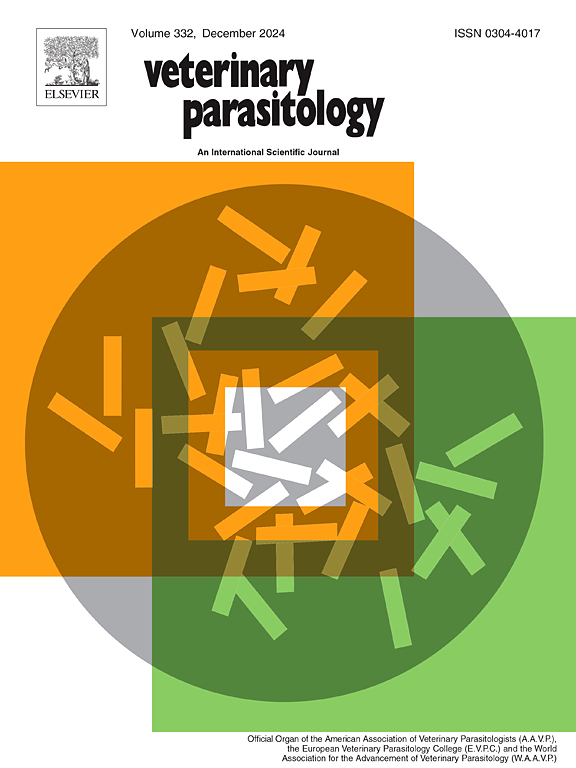Resistance of Rhipicephalus microplus to different acaricides in tropical climates: Are the laboratory and field results related?
IF 2.2
2区 农林科学
Q2 PARASITOLOGY
引用次数: 0
Abstract
The aim of this study was therefore to investigate the relationship between laboratory (Larval Packet Test -LPT; Larval Immersion Test – LIT; Adult Immersion Test – AIT) and field studies using active ingredients or commercial formulations to control R. microplus in a tropical region. This comparative study was carried out with four populations of R. microplus from four Brazilian farms. For laboratory assays, technical grade compounds of cypermethrin and chlorpyrifos were used in the LPT, while fipronil and ivermectin were used in the LIT. The AIT was conducted using commercial spray formulations containing pyrethroid and organophosphate: cypermethrin 187.5 ppm + chlorpyrifos 375 ppm + fenthion 187.5 ppm and chlorpyrifos 825 ppm + High-Cis cypermethrin 99 ppm. For the field assays, the same commercial products of the AIT used, a pour-on formulation of fipronil 1 mg/kg, injectable 200 µg/kg ivermectin, injectable 630 µg/kg ivermectin, injectable 200 µg/kg doramectin and injectable 200 µg/kg moxidectin. For field studies, populations of R. microplus with the mean therapeutic efficacy ≤89 %, on days 7 up to 21 post-treatment, were classified as resistant to such compounds. To standardize the comparative analysis between laboratory and field results, this same value of larval efficacy or mortality (≤89 %) was used to classify the population as resistant by laboratory tests (LPT, LIT, and AIT). Of the 16 laboratory tests conducted using R. microplus larvae (LPT and LIT), 66.6 % showed no relation with field study results. Inconsistencies were observed in 100 % of cases for spray formulations, 25 % for fipronil, and 75 % for macrocyclic lactones. Although the efficacy results of the AIT with commercial formulations were slightly higher than the therapeutic efficacy observed in the field, it is important to note that there was a 100 % positive relation in the classification of the status of the four populations, which were all considered susceptible in both laboratory and field analyses. These findings demonstrate that, in situations like this study, it is essential to calibrate laboratory tests using larvae, particularly against field results, for each formulation. This approach will allow for more accurate recommendations regarding the use of a chemical formulation for a specific tick population. Furthermore, it reduces the risk of incorrectly identifying R. microplus population as resistant or susceptible and helps clarify the practical implications of resistance.
热带气候下 Rhipicephalus microplus 对不同杀螨剂的抗药性:实验室和实地结果是否相关?
因此,本研究的目的是探讨实验室(幼虫包测试-LPT;幼虫浸泡试验;成人浸没试验(AIT)和使用有效成分或商业配方控制热带地区微孢子虫的实地研究。本研究对来自巴西4个农场的4个种群进行了比较研究。在实验室分析中,LPT使用氯氰菊酯和毒死蜱的工业级化合物,LIT使用氟虫腈和伊维菌素。AIT使用含有拟除虫菊酯和有机磷酸盐的商业喷雾配方进行:氯氰菊酯187.5 ppm + 毒死蜱375 ppm + 倍硫磷187.5 ppm和毒死蜱825 ppm + 高顺氯氰菊酯99 ppm。对于现场试验,AIT使用相同的商业产品,氟虫腈1 mg/kg,可注射200 µg/kg伊维菌素,可注射630 µg/kg伊维菌素,可注射200 µg/kg多拉菌素,可注射200 µg/kg莫西菌素。野外试验结果显示,处理后第7 ~ 21天,平均治疗效果≤89 %的小褐家鼠种群均为耐药。为了使实验室和现场结果的比较分析标准化,采用相同的幼虫药效或死亡率(≤89 %),通过实验室检测(LPT、LIT和AIT)将种群划分为抗性。在16项室内试验中(LPT和LIT), 66.6% %与现场研究结果不相关。在100 %的喷雾剂配方、25 %的氟虫腈和75 %的大环内酯中观察到不一致。尽管使用商业配方的AIT的疗效结果略高于现场观察到的治疗疗效,但重要的是要注意,在实验室和现场分析中都被认为是易感的四种人群的状态分类中存在100% %的正相关。这些发现表明,在像本研究这样的情况下,必须对使用幼虫的实验室测试进行校准,特别是根据现场结果对每种配方进行校准。这种方法将允许对特定蜱虫种群使用化学制剂提出更准确的建议。此外,它还降低了错误地将微褐藻种群识别为耐药或易感的风险,并有助于阐明耐药的实际意义。
本文章由计算机程序翻译,如有差异,请以英文原文为准。
求助全文
约1分钟内获得全文
求助全文
来源期刊

Veterinary parasitology
农林科学-寄生虫学
CiteScore
5.30
自引率
7.70%
发文量
126
审稿时长
36 days
期刊介绍:
The journal Veterinary Parasitology has an open access mirror journal,Veterinary Parasitology: X, sharing the same aims and scope, editorial team, submission system and rigorous peer review.
This journal is concerned with those aspects of helminthology, protozoology and entomology which are of interest to animal health investigators, veterinary practitioners and others with a special interest in parasitology. Papers of the highest quality dealing with all aspects of disease prevention, pathology, treatment, epidemiology, and control of parasites in all domesticated animals, fall within the scope of the journal. Papers of geographically limited (local) interest which are not of interest to an international audience will not be accepted. Authors who submit papers based on local data will need to indicate why their paper is relevant to a broader readership.
Parasitological studies on laboratory animals fall within the scope of the journal only if they provide a reasonably close model of a disease of domestic animals. Additionally the journal will consider papers relating to wildlife species where they may act as disease reservoirs to domestic animals, or as a zoonotic reservoir. Case studies considered to be unique or of specific interest to the journal, will also be considered on occasions at the Editors'' discretion. Papers dealing exclusively with the taxonomy of parasites do not fall within the scope of the journal.
 求助内容:
求助内容: 应助结果提醒方式:
应助结果提醒方式:


